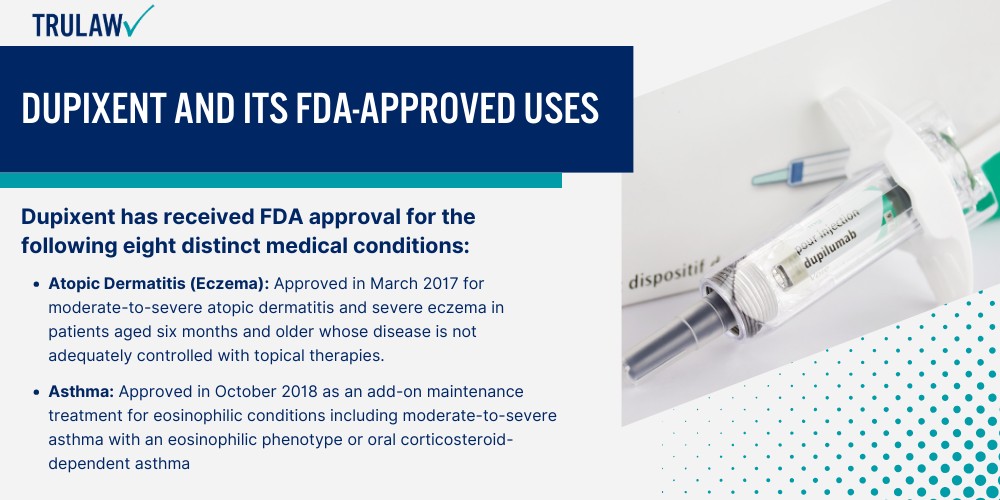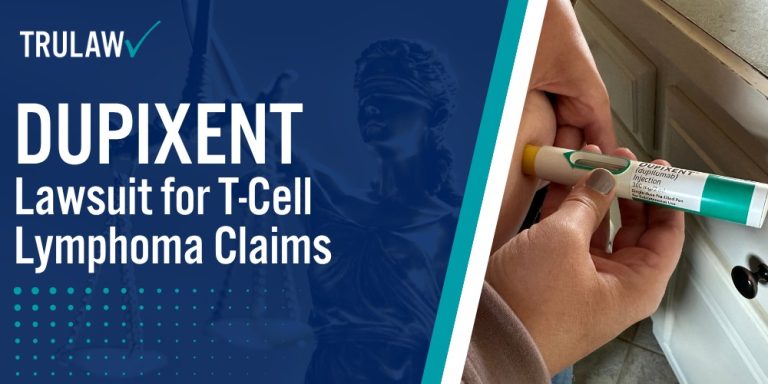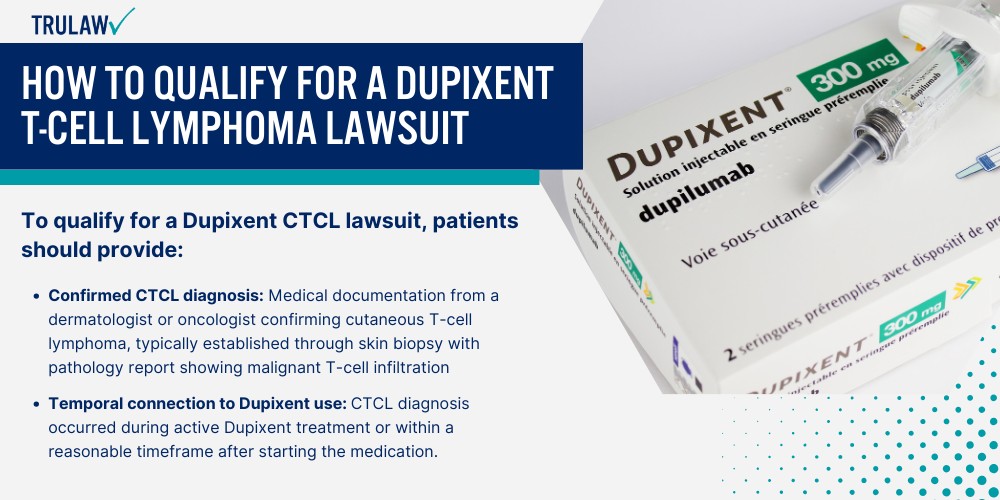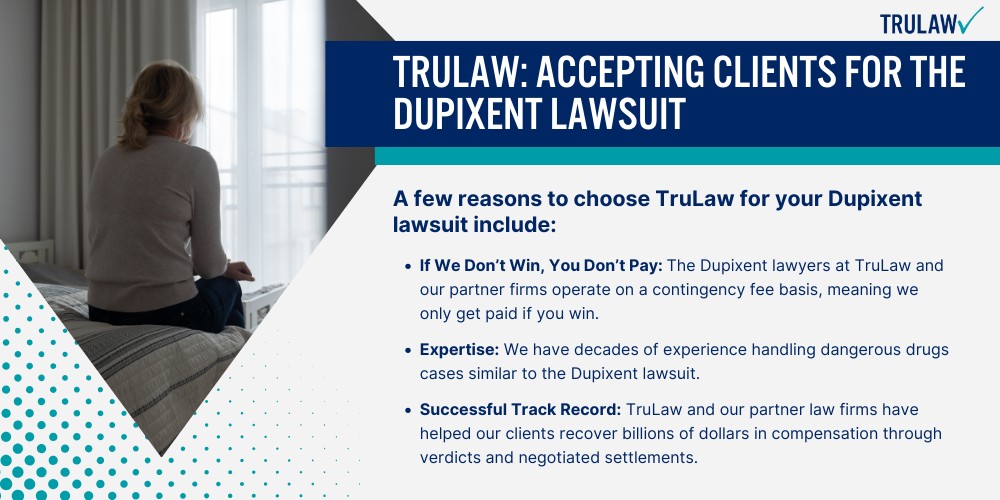Dupixent (dupilumab) is a biologic medication manufactured by Sanofi and Regeneron Pharmaceuticals that has gained widespread use since its initial FDA approval in 2017.
The drug is prescribed as monotherapy rather than a drug combination for multiple inflammatory conditions, including moderate-to-severe atopic dermatitis (eczema), asthma, chronic rhinosinusitis with nasal polyps, eosinophilic esophagitis, prurigo nodularis, and chronic obstructive pulmonary disease.

While Dupixent has helped millions manage debilitating inflammatory conditions, emerging evidence has revealed serious adverse effects including safety concerns about cancer risks that were not adequately disclosed to patients and healthcare providers at the time of prescribing.
How Dupixent Works in the Body
Dupixent functions as a human monoclonal antibody that fundamentally alters immune system function by targeting specific inflammatory pathways.
The given drug binds to the interleukin-4 receptor alpha (IL-4Rα) subunit, which is shared by both the IL-4 and IL-13 receptor complexes.
By blocking this receptor, Dupixent (unlike any similar drug previously approved) prevents both interleukin-4 and interleukin-13 from sending signals that trigger inflammatory responses in the body.
While this mechanism effectively reduces inflammation associated with conditions like eczema and asthma, research published in peer-reviewed journals has demonstrated that blocking IL-4 and IL-13 signaling also suppresses important immune surveillance functions.
A February 2024 study published in the PMC database noted that IL-4 and IL-13 play roles in tumor immunosurveillance, meaning these proteins help the immune system detect and eliminate abnormal cells, including cancer cells.
When Dupixent blocks these pathways, it may create conditions that allow dormant T-cell lymphomas to develop or accelerate their progression.
The drug works by preventing the dimerization (joining) of receptor subunits that would normally occur when IL-4 or IL-13 bind to their receptors.
This blocks the downstream activation of STAT6 and other signaling molecules that drive inflammatory responses.
However, this same blockade may interfere with the immune system’s ability to recognize and destroy malignant T-cells before they proliferate into lymphoma.
With over one million patients globally taking Dupixent as of 2025, including those with a condition called eosinophilia, and many remaining on the medication for years due to its intended use as a long-term treatment, the potential for cancer development creates substantial public health concerns.
Clinical trials have followed patients for up to five years of continuous Dupixent use, meaning hundreds of thousands of individuals have experienced prolonged immune suppression.
Common Conditions Treated with Dupixent
Dupixent has received FDA approval for eight distinct indications across multiple medical specialties, making it one of the most versatile biologic medications on the market.
The breadth of approved uses has contributed to its rapid adoption and widespread patient exposure.
Dupixent has received FDA approval for the following eight distinct medical conditions:
- Atopic Dermatitis (Eczema): Approved in March 2017 for moderate-to-severe atopic dermatitis and severe eczema in patients aged six months and older whose disease is not adequately controlled with topical therapies. This remains the primary indication with the highest patient volume
- Asthma: Approved in October 2018 as an add-on maintenance treatment for eosinophilic conditions including moderate-to-severe asthma with an eosinophilic phenotype or oral corticosteroid-dependent asthma
- Chronic Rhinosinusitis with Nasal Polyps (CRSwNP): Approved for adults with inadequately controlled chronic sinus inflammation accompanied by nasal polyps
- Eosinophilic Esophagitis (EoE): Approved for patients aged one year and older weighing at least 15 kg with eosinophilic inflammation of the esophagus
- Prurigo Nodularis: Approved for adults with this rare skin condition characterized by intensely itchy nodules
- Chronic Obstructive Pulmonary Disease (COPD): Approved as an add-on maintenance treatment for adults with inadequately controlled COPD experiencing worsening shortness of breath and an eosinophilic phenotype
Dupixent is prescribed across dermatology for conditions ranging from atopic dermatitis to eyelid inflammation, plus pulmonology for asthma patients, allergology, and gastroenterology practices, meaning patients diagnosed with CTCL after Dupixent use may have received the medication for any of these conditions.
The drug is typically administered as a subcutaneous Dupixent injection every two or four weeks, depending on the condition being treated and patient age.
Treatment with this given drug is intended to be long-term and continuous rather than a fixed-duration therapy.
Clinical studies have evaluated safety and efficacy for up to five years of continuous use, monitoring whether patients gain weight or develop other issues, and patients are generally maintained on the medication indefinitely as long as it remains effective.
This extended exposure period increases the cumulative risk of adverse events, including cancer development.
Real-world evidence shows that many patients remain on Dupixent for multiple years, with some studies tracking outcomes for 36 months or longer.
The prolonged immune suppression associated with years of IL-4 and IL-13 blockade may progressively increase cancer risk over time beyond common injection site reactions, particularly for rare malignancies like cutaneous T-cell lymphoma that may require extended latency periods to become clinically apparent.
If you or a loved one developed cutaneous T-cell lymphoma or another form of T-cell malignancy after taking Dupixent for any FDA-approved indication, TruLaw partners with Dupixent litigation leaders to evaluate your case and provide the legal resources necessary for pursuing compensation.
Contact TruLaw using the chat on this page to receive an instant case evaluation and determine whether you qualify to file a Dupixent Lawsuit today.






